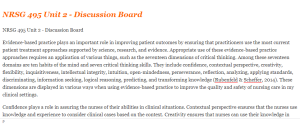NRSG 495 Unit 2 – Discussion Board
Sample Answer for NRSG 495 Unit 2 – Discussion Board Included
NRSG 495 Unit 2 – Discussion Board
A Sample Answer For the Assignment: NRSG 495 Unit 2 – Discussion Board
Title: NRSG 495 Unit 2 – Discussion Board
Evidence-based practice plays an important role in improving patient outcomes by ensuring that practitioners use the most current patient treatment approaches supported by science, research, and evidence. Appropriate use of these evidence-based practice approaches requires an application of various things, such as the seventeen dimensions of critical thinking. Among these seventeen domains are ten habits of the mind and seven critical thinking skills. They include confidence, contextual perspective, creativity, flexibility, inquisitiveness, intellectual integrity, intuition, open-mindedness, perseverance, reflection, analyzing, applying standards, discriminating, information seeking, logical reasoning, predicting, and transforming knowledge (Rubenfeld & Scheffer, 2014). These dimensions are displayed in various ways when using evidence-based practice to improve the quality and safety of nursing care in my clinical settings.
Confidence plays a role in assuring the nurses of their abilities in clinical situations. Contextual perspective ensures that the nurses use

knowledge and experience to consider clinical cases based on the context. Creativity ensures that nurses can use their knowledge in multiple ways as they consider clinical situations (Chaisuwan et al.,2019). Flexibility also allows nurses to consider others’ opinions regarding various cases in the clinical setting. Inquisitiveness prompts practitioners to explore other treatment and management standards to help solve situations by taking their time to read existing literature and guidelines (Sasson et al.,2018). Intellectual integrity prompts nurses to seek the most effective standards for specific patient care and clinical situations. Intuition allows nurses to combine knowledge with inner feelings when offering care to patients. Open-mindedness also allows nurses to steer clear of rote thinking and probe the most commonly considered etiologies and diagnoses with sufficient data. Perseverance also enables nurses to overcome various obstacles in clinical settings, while reflection enables nurses to acquire and demonstrate a deeper understanding in clinical settings.
Critical thinking skills are also used. Analyzing is used in considering the meaning of particular data in connection to possible diagnoses. Applying standards is used to select the most befitting standard for a situation. Discriminating considers the similarity and differences in a particular situation to come up with a relevant and most appropriate diagnosis. Information seeking is used in exploring the need for additional information for a more accurate diagnosis (Kaya et al.,2018). In addition, logical reasoning explores the relevance of data to a particular situation. Predicting is used to anticipate data implications and how the same is connected to nursing intervention and diagnosis. Finally, transforming knowledge is used in a way that past knowledge is integrated with current knowledge to adapt to a particular clinical situation.
Click here to ORDER an A++ paper from our Verified MASTERS and DOCTORATE WRITERS: NRSG 495 Unit 2 – Discussion Board
NRSG 495 Unit 2 – Discussion Board References
Chaisuwan, C., Kelly, K., Kelman, G. B., & Continelli, T. (2021). The Relationship between Cultural Value and Critical Thinking Dispositions and their Difference among Nursing Students in Thailand and United States. Pacific Rim International Journal of Nursing Research, 25(2), 199–212. https://he02.tci-thaijo.org/index.php/PRIJNR/article/view/242571
Kaya, H., Şenyuva, E., & Bodur, G. (2018). The relationship between critical thinking and emotional intelligence in nursing students: A longitudinal study. Nurse Education Today, 68, 26-32.
Rubenfeld, M. G., & Scheffer, B. (2014). Critical thinking tactics for nurses. Jones & Bartlett Publishers.
Sasson, I., Yehuda, I., & Malkinson, N. (2018). Fostering the skills of critical thinking and question-posing in a project-based learning environment. Thinking Skills and Creativity, 29, 203-212. https://doi.org/10.1016/j.tsc.2018.08.001
Description
Primary Task Response: Within the Discussion Board area, write 300–500 words that respond to the following questions with your thoughts, ideas, and comments. This will be the foundation for future discussions by your classmates. You are required to use 2 scholarly resources, in addition to your textbook. Be substantive and clear, and use examples to reinforce your ideas.
There are 17 dimensions of critical thinking (10 habits of the mind and 7 critical thinking skills). The 10 habits of the mind include the following (Rubenfeld & Scheffer, 2014):
- Confidence
- Contextual perspective
- Creativity
- Flexibility
- Inquisitiveness
- Intellectual integrity
- Intuition
- Open-mindedness
- Perseverance
- Reflection
The 7 critical thinking skills are as follows (University of Michigan, n.d.):
- Analyzing
- Applying standards
- Discriminating
- Information seeking
- Logical reasoning
- Predicting
- Transforming knowledge
Discuss how these dimensions are displayed when using evidence-based practices to improve the quality and safety of nursing care in your clinical setting.
Responses to Other Students: Respond to at least 2 of your fellow classmates with at least a 150-word reply about their Primary Task Response regarding items you found to be compelling and enlightening. To help you with your discussion, please consider the following questions:
- What did you learn from your classmate’s posting?
- What additional questions do you have after reading the posting?
- What clarification do you need regarding the posting?
- What differences or similarities do you see between your posting and other classmates’ postings?
For assistance with your assignment, please use your textbook and all course resources.
NRSG 495 Unit 2 – Discussion Board Rubric
The Discussion Board Grading Rubric is a scoring tool that represents the performance expectations for the discussion. This Discussion Board Grading Rubric is divided into components that provide a clear description of what should be included within each component of the discussion. It’s the roadmap that can help lead your discussion. Discussion Board Grading Rubric
NRSG 495 Unit 2 – Discussion Board References
University of Michigan. (n.d.). Critical thinking habits of the mind. http://www.umich.edu/~elements/probsolv/strategy/ctmind.htm
Rubenfeld, M. G., & Scheffer, B. K. (2014). Critical thinking tactics for nurses: Achieving the IOM competencies (3rd ed.). Jones & Bartlett Learning.

